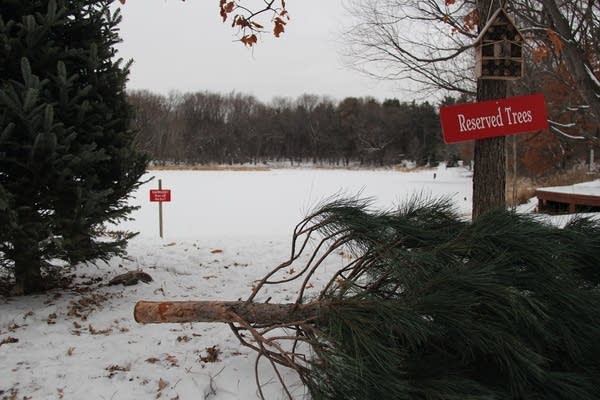Your Christmas tree has an environmental footprint. Here's how to minimize it

Go Deeper.
Create an account or log in to save stories.
Like this?
Thanks for liking this story! We have added it to a list of your favorite stories.
The holiday season brings an annual dilemma for environmentally inclined folks: get a real Christmas tree, or go artificial?
Turns out the answer isn't as simple as the question.
"This is complicated topic and anyone who thinks they have a definitive answer is lying," said Lee Frelich, a University of Minnesota forest ecologist.
If you're going to keep a Christmas tree, there isn't a clear-cut answer on which option is easiest on the earth. Minimizing impact depends on how each person purchases and disposes of their tree.
Turn Up Your Support
MPR News helps you turn down the noise and build shared understanding. Turn up your support for this public resource and keep trusted journalism accessible to all.
Let's dive into what makes trees green, or not so much.
Real trees' impact: Transportation, chemicals
Neil and Deb Krueger's Christmas tree farm in Lake Elmo, Minn., looks like a movie set. They live there, serve cider to guests in a warming house near a wooded pond. Their family works the 50-acre farm, helping customers get their tree cut down and secured to their vehicle's roof.

"We plant between 6,000 and 7,000 trees every year, different species," Deb Krueger said. "This is our home, our life, our joy and where we raised our children. Not too many people can walk out their backdoor and arrive in their business."
They do a lot to make their farm sustainable, like planting a tree for each one they cut down. That makes the trees essentially neutral on carbon emissions — a tree gives off its carbon when cut down, but a tree planted in its place absorbs that amount as it grows.
The Kruegers even use cover crops on different fields each year to help restore the soil.
Real trees' environmental impacts come from transportation to and from where they're sold, and the chemicals used to help them grow.
Transportation is the big part of the footprint. For example, trees for sale might come from Wisconsin or Canada.
The Kruegers are members of the Minnesota Christmas Tree Association, which helps them source all their trees from Minnesota.
Trees take an ever-growing amount of chemicals to help them along on their 10-year growth from seed to Christmas tree.
"Unfortunately there are a lot of fungal diseases that infect conifer needles and turn them brown these days," Frelich said, "and it seems like those diseases are increasing all the time because of these extremely hot, humid, rainy periods of weather that we get in the summer now with the warmer climate."
At the end of their life-cycle, real trees can be recycled into mulch. Even if they wind up in a landfill, they decompose.
About a fifth of the Kruegers' customers bring their trees back to the farm for recycling. The old trees become mulch that help grow a future generation of trees, they said, and customers like it.

"They're proud of themselves that they can bring the tree back and that we can chip it up and put it back where it came from," Deb Krueger said.
Artificial trees take heavy materials and a long trip to the U.S.
The buying experience for artificial trees might take you as far as the local Target or Walmart. No free cider, but you don't need to make the trip annually.
A single artificial tree has a far greater impact on the environment than a single real tree.
Most artificial trees are made from plastic (usually PVC plastic) and steel. They're mostly made overseas in China.
So, there's oil and other natural resources used, plus the carbon emitted in shipping the trees to the U.S. To make an artificial tree the more sustainable option, you need to use it for several years, though it's not clear how many.
The American Christmas Tree Association — which represents artificial tree manufacturers — commissioned research that wound up favoring its own interests. Sort of.
The study concluded that artificial trees have less environmental impact than buying a new, real tree every year if a person uses the artificial tree for five or more years. But that doesn't mean reused artificial trees are always best.

"I would suspect organic gardening, organic growing of trees may be more beneficial in the long run," said Brad McAllister of WAP Sustainability Consulting, which did the research for the ACTA. "I don't know that because we didn't study that."
So what's a buyer to do?
If you want to minimize even your tree's impact, McAllister offered some simple tips:
• If you want a real tree, try buying local. Transportation is a major factor for real trees' environmental footprint.
• Artificial tree users should keep their tree at least five years. And when it's time for a new one, try keeping it out of a landfill — consider giving your old tree to someone else who could use it.
And remember: trees are only a tiny fraction of the holidays' footprint. Just having Christmas lights on your tree and plugging them in has a bigger environmental impact than a tree, McAllister said.
He said it's important to consider everything else: "All the travel associated with going to see relatives, or all the heavy meat-based meals that we all have around Christmas time, or the amount of gift-giving.
"The trees in and of themselves is a small environmental impact. It's really a drop in the bucket of the typical American around Christmas time."


